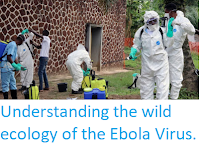Authorities in the Democratic Republic of Congo have reported a new outbreak of Ebola Haemorrhagic Fever in the city of Mbandaka in Équateur Province in the north-western part of the country. A total of five people, including a fifteen-year-old girl are reported to have died between 18 and 30 May 2020, with laboratory tests having now confirmed that the infective agent was Ebolavirus. Another four people, including a child of one of the deceased, are reported to have fallen ill with the disease, and are receiving treatment at a specialist unit at Wangata Hospital in Mbandaka. Several more people who are known to have come into contact with infected persons are being held in isolation until they can be confirmed to be clear of the Virus.
The entrance to the specialist isolation unit at Wangata Hospital in Mbandaka. Junior Kannah/AFP.
The Democratic Republic of Congo is still officially suffering from another outbreak of Ebola in North Kivu Province in the east of the country, which has seen 3317 infections and 2134 deaths since August 2018. It is hoped that this outbreak may have been defeated, with no new cases reported since 15 May, although the World Health Organisation recomends that an area is not declared clear of the Virus until there have been no new cases for 42 days, a threashold that was nearly reached in North Kivu at the begining of April, when the disease flared up again.
Ebola Haemorrhagic Fever is caused by RNA Viruses of the genus Ebolavirus.
It has a reputation for being the world's deadliest viral disease, at
least in part due to the 1995 film Outbreak, though this is probably
slightly inaccurate as about 50% of victims survive, making it less
deadly than diseases such as Rabies. However, it is extremely contagious,
with know known cure, and has a tendency to rapidly
overwhelm local health systems as health workers themselves are
infected.
Electron micrograph of an Ebola Virus particle. Frederick Murphy/Centers for Disease Control and Prevention/Wikimedia Commons.
Ebola begins with a fever similar to that caused by Influenza or
Malaria, which tends to come on rapidly two-to-three weeks after
infection (during at least part of which time the patient is already
infectious). This tends to be followed by extreme respiratory tract
infection, headaches, confusion, rashes and tissue necrosis and heavy
bleeding. Death is generally caused by multiple organ failure.
The only known treatment for Ebola is intensive rehydration, which can
improve the survival prospects of patients greatly, accompanied by
anticoagulants and procoagulants to mange the diseases attacks on the
circulatory system, analgesia to cope with the pain of the disease and
antibiotics and antimycotics to prevent secondary infection. Due to the
highly contagious nature of the disease it is recommended that
healthcare workers wear full-body protection to maintain a barrier
between them and their patients; a daunting prospect in the tropical
regions of Africa where the disease is endemic.
Ebolavirus is thought to have a non-human animal vector, since
its rapid onset and high mortality rate appears to preclude a permanent
residence within Human hosts. Surveys of wild animals have found Ebola
infections in Rodents and Great Apes, however these were affected by the
disease in a similar way to Humans, and are therefore unlikely
permanent hosts. The most likely vectors are thought to be Fruit Bats or
small Primates, which are endemic to the areas where the disease occurs
and which are widely eaten; cooking meat probably kills the virus, but
there is a distinct danger of infection while preparing carcasses.
See also...
Follow Sciency Thoughts on Facebook.








